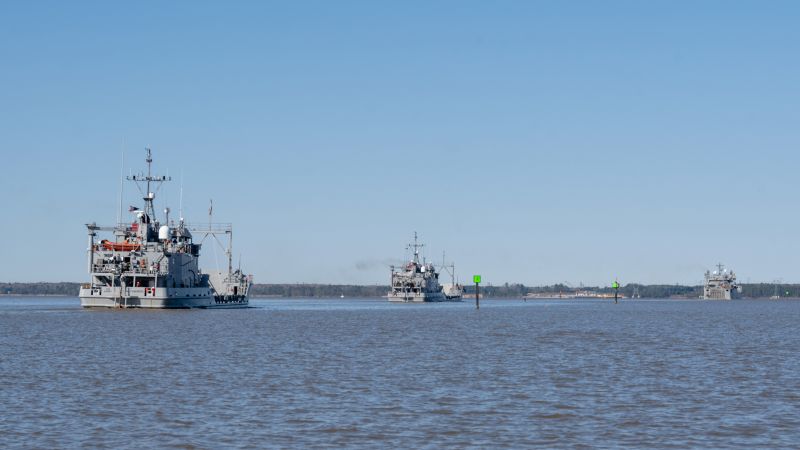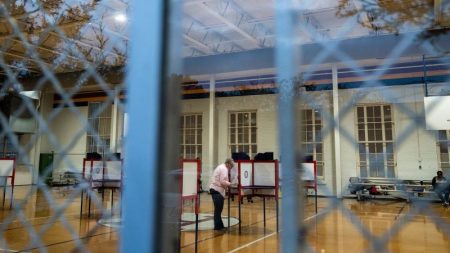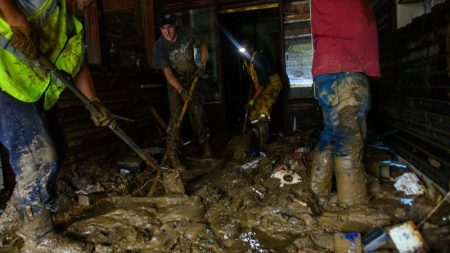Roughly seven months after setting sail for the US military’s troubled temporary pier mission off the Gaza coast, three US Army boats are expected to have to be hauled back to the US by contracted civilian vessels behind schedule, raising more concern about the state of the Army watercraft at the center of a major effort to bring humanitarian aid into war-torn Gaza.
“[C]oordination is underway for the [landing craft utility ships] to be transported back on contracted Float-On/Float-Off vessels with an expected ETA of late-October,” Col. Mary Ricks, the spokesperson for the Army’s 18th Airborne Corps, told CNN on Wednesday. The military has not yet locked in a contract for that job, she added.
Three boats deployed in March for the mission: the US Army Vessels Monterrey, Matamoros, and Wilson Wharf. The Pentagon had previously said that all personnel and equipment used with the temporary pier — called the Joint Logistics Over-the-Shore, or JLOTS — were scheduled to be home by mid-September.
It’s unclear how much the contract to bring the vessels back will cost the military. A spokesperson for Military Sealift Command told CNN the contract is “currently in the procurement phase, which means it is out for competitive bids.”
Retired Marine Corps Col. Mark Cancian, a senior adviser with the CSIS International Security Program, estimated that the contract would go for $300,000 per float-on/float-off vessel, which would be used to transport the three boats. The contract description says it is for “multiple awards up to two vessels or until the Government’s needs are met,” meaning it could come out to roughly $600,000 total if two vessels are required.
The pier was announced by President Joe Biden in his State of the Union address in March.
“A temporary pier would enable a massive increase in the amount of humanitarian assistance getting into Gaza every day,” Biden said.
But in the end it was only operational for roughly 20 days at a cost of the $230 million and did little to alleviate the grave humanitarian situation in Gaza as the war between Hamas and Israel, which has claimed thousands of civilian lives, continues.
Deputy Commander of US Central Command, Vice Adm. Brad Cooper, told reporters in July that the pier helped deliver 19.4 million pounds of aid to the desperate population in Gaza.
With the end of the pier mission, officials said humanitarian aid was expected to be delivered from Cyprus through Israel’s Ashdod port to Gaza. Approximately six million pounds of aid still remains in Cyprus on the Motor Vessel Cape Trinity, awaiting delivery to Gaza.
A retired warrant officer who served as a chief engineer on Army watercraft told CNN that the boats being brought home by contracted vessels indicates they likely need significant maintenance.
“The only things that would stop [7th Transportation Brigade (Expeditionary)] from sailing are mechanical problems or manning,” the retired engineer said. “Unless the whole unit is deploying somewhere, that means these boats are in rough shape.”
A publicly available description of the contract says Military Sealift Command is looking for float-on/float-off vessels capable of carrying the boats from Rota, Spain, to Norfolk, Virginia, by November 5 at the latest. Public ship tracking data as of Wednesday showed that the boats were near Greece.
It’s not entirely uncommon for the US military to use float-on/float-off vessels to transport smaller ships across large distances, or if a US military vessel is badly damaged, Cancian said. He added it’s “very plausible” that the boats are not in a state to make the journey back after their work on the pier operation.
“They’d probably make it but, again, it’s a matter of risk,” he said. “They don’t want one to get halfway across and have the engines break down and have it floating around.”
Maintenance of the Army’s vessels was a concern throughout the mission of the temporary pier, which ended in July. A US official previously told CNN that the watercraft involved in the mission have not been maintained “to the level they need to be,” primarily because “they lack the funding to get the repair parts in a timely manner.”
The pier mission caught the attention of the Pentagon and USAID inspectors general, who launched coordinated reviews of the humanitarian mission to Gaza in June. The Pentagon’s inspector general announced a separate probe just earlier this month, separate from the coordinated review with USAID. In a memo dated August 5, the IG office said it would conduct a “comprehensive assessment” of the Pentagon’s “capabilities to effectively carry out” operations and exercises using JLOTS. The memo was first reported by Military.com.
It has presented further issue for one of the larger Army vessels expecting to set sail in the near future. A defense official said one of the logistics support vessels, the Charles P. Gross (LSV-5), has to undergo more maintenance before it can begin its journey home.
Another of the vessels, the USAV Frank S. Besson (LSV-1), is currently underway and is expected to arrive back in the US by the end of August, Ricks said. The USAV James A. Loux (LSV-6), is expected to be underway “soon” and to arrive in the US by late September.
The issues with the boats are just the latest in an operation that was plagued by logistical problems. After only roughly a week of going operational in May, the pier broke apart and four Army vessels were beached. The military detached it from the beach two more times out of concerns over weather conditions before ending the mission in July.
Since the mission ended, more than 350 soldiers from the unit assisting have since returned to Virginia, Ricks said. Pentagon spokesman Tom Crosson said last week that roughly 200 sailors on the mission had also since returned home. The retired engineer added that 350 soldiers coming home would not impact the unit’s ability to sail the boats back.
Read the full article here















